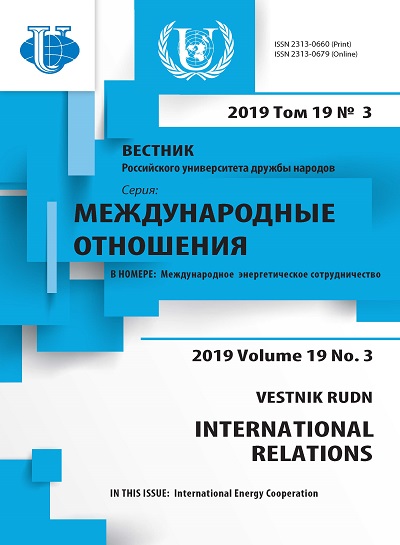Osobennosti kul'turnoy diplomatii Italii na sovremennom etape
- Authors: Bokeriya S.A.1, Danilov V.V.1
-
Affiliations:
- RUDN University
- Issue: Vol 19, No 4 (2019): Islamic Factor in World Politics
- Pages: 643-653
- Section: PEACE AND SECURITY
- URL: https://journals.rudn.ru/international-relations/article/view/22843
- DOI: https://doi.org/10.22363/2313-0660-2019-19-4-643-653
Cite item
Full Text
Abstract
The article analyzes the cultural policy of Italy, which is one of the key soft power instruments of the country, along with public diplomacy, the Italian language, education and scientific activities, through the prism of the cultural strategy of the EU. Despite the presence of a large number of articles on soft power implementation, this issue remains insufficiently covered today, since the concept of soft power emerged at the end of the 20th century in the framework of the American international relations school (J. Nye) and the majority of academic foreign papers are still devoted to the American soft power model. It is revealed that scientific community paid not enough attention to the Italian soft power phenomenon. The author’s goal is to analyze the cultural model of Italy, used as one of soft power component. According to the results of the structural, comparative and institutional analysis, fundamental problems in the development of the Italian cultural model were identified, as well as the links between the successful adoption of cultural diplomacy and economic crisis. The governmental initiatives in Italy in realization of cultural diplomacy and the EU cultural strategy are thoroughly reviewed. The analysis of the activities of specialized government institutions responsible for the cultural promotion of the country and the Italian language abroad is carried out. The soft power rankings, reflecting the effectiveness of cultural policy, in particular, Anholt-GfK Nation Brands Index and The Soft Power 30 are being analyzed. Measures to ensure the efficient use of the soft power resources in Italy are proposed. They are mostly aimed at combining the activities of existing institutions and forming an integrated strategy for popularizing, financing and broadening soft power components both within the state and foreign policy strategy.
Keywords
About the authors
Svetlana Aleksandrovna Bokeriya
RUDN University
Author for correspondence.
Email: bokeria-sa@rudn.ru
PhD in Jurisprudence, Associate Professor, Department of Theory and History of International Relations
Moscow, Russian FederationValerij Vitalevich Danilov
RUDN University
Email: danucci@yandex.ru
Postgraduate Student, Faculty of Humanities and Social Sciences, Department of History and Theory of International Relations
Moscow, Russian FederationReferences
- Anholt, S. (2005). Brand New Justice: How Branding Places and Products Can Help the Developing World. Amsterdam: Butterworth Heinemann.
- Bazhanov, E.P. & Bazhanova, N.E. (2011). Italy, Both Sad and Merry. Travel Notes. Moscow: Vostok — Zapad publ. (In Russian).
- Bobylo, A.M. (2013). “Soft Power” in International Politics: Peculiarities of National Strategies. Bulletin of Buryat State University, 14, 129—135. (In Russian).
- Bokeriya, S.A. & Sokolova, N.V. (2014). Soft Power in the System of French Security (the Example of la Francophonie). Vestnik RUDN. International Relations, 2, 93—100. (In Russian).
- Cummings, M. (2003). Cultural Diplomacy and the United States Government. Center for Arts and Culture. URL: https://www.americansforthearts.org/sites/default/files/MCCpaper.pdf (accessed: 28.02.2019).
- Donfried, M.D. & Gienow-Hecht, J.C.E. (Eds.). (2010). Searching for a Cultural Diplomacy. NY, Oxford: Berghahn Books.
- Eleskina, O.V. (2015). Some Aspects of the EU Cultural Policy. Bulletin of Kemerovo State University, 3—2 (63), 115—119. (In Russian).
- Feigenbaum, H.B. (2001). Globalization and Cultural Diplomacy. Center for Arts and Culture. URL: https://www.americansforthearts.org/sites/default/files/globalization_0.pdf (accessed: 28.02.2019).
- Hayden, C. (2011). The Rhetoric of Soft Power: Public Diplomacy in Global Contexts. Lanham, MD, United States: Lexington Books.
- Kovba, D.M. (2017). The Main Approaches to the Study of Soft Power in the Domestic Political Science. Discourse-P, 1, 143—148. (In Russian).
- Mironova, T.N. (2009). Preservation of Cultural and Natural Heritage as the Main Feature of Cultural Policy of the European Region Countries: Italy. Znanie. Ponimanie. Umenie, 2, 41—48. (In Russian).
- Nye Jr., J.S. (2005). Soft Power: The Means to Success in World Politics. NY: PublicAffairs.
- Nye Jr., J.S. (2017). Soft Power: The Origins and Political Progress of a Concept. Palgrave Communications, 3, 1—3. doi: 10.1057/palcomms.2017.8
- Pajtinka, E. (2014). Cultural Diplomacy in Theory and Practice of Contemporary International Relations. Political Sciences, 4, 95—108.
- Riordan, S. (2003). The New Diplomacy. London: Polity.
- Tabarintseva-Romanova, K.M. (2014). “Italsimpatia” as an Element of Cultural Diplomacy in the Development of RussianItalian Relations. The Italian Republic in a Changing World: Reports of the Institute of Europe, 306. Moscow: Institute of Europe RAS publ. P. 65—71. (In Russian).
- Tabarintseva-Romanova, K.M. (2017). Development of the EU’s External Cultural Policy after the Treaty of Lisbon. Contemporary Europe, 4 (76), 98—108. (In Russian).
- Vasilenko, E.V. (2013). “Soft power” of the Image Policy of Italy. World and Politics. The Scientist, 10, 222—232. (In Russian).
- Zonova, T.V. (2004). Diplomacy of Italy. In: Zonova, T.V. (Eds.). Diplomacy of Foreign Countries. Moscow: ROSSPEN publ. (In Russian).
- Zvyagina, D.A. (2012). “Soft Power”: Structural Analysis. Initiatives of the 21st Century, 3, 135—137. (In Russian).











